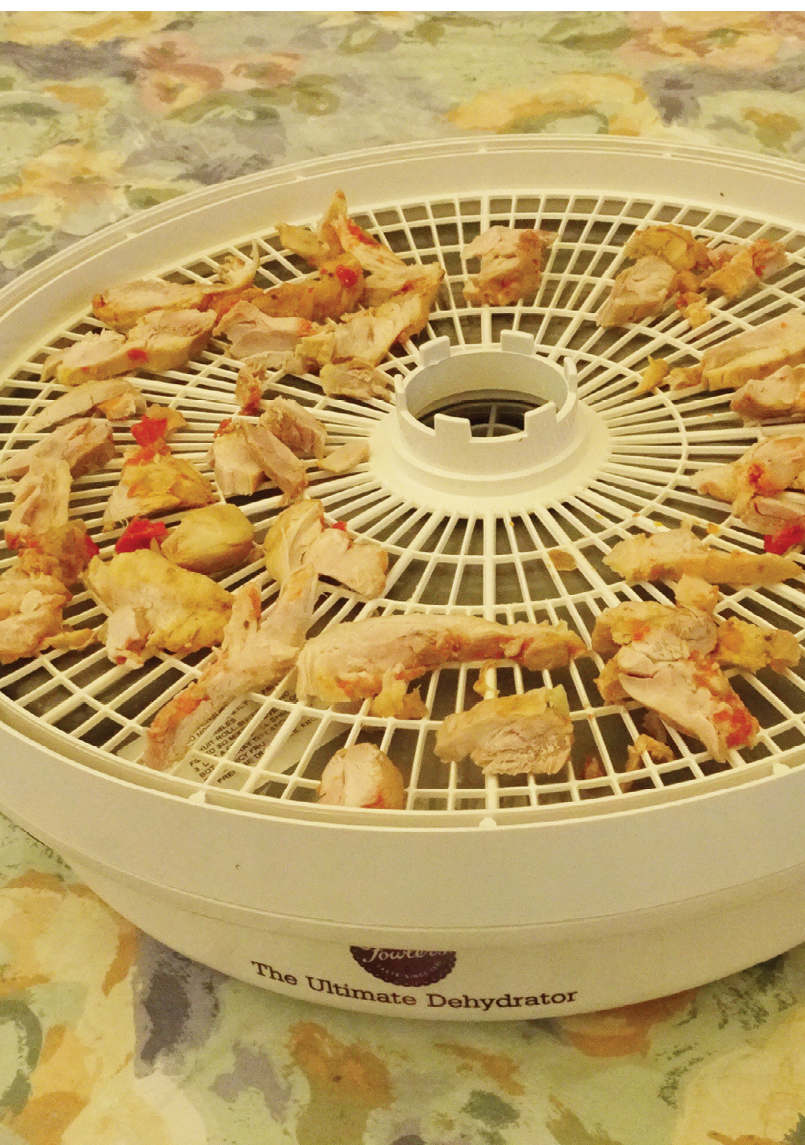

15 Things You May Have Never Known About Dehydrating Foods
Sonya Muhlsimmer



Chicken prepared for dehydration
So you know what drying is right, it is the physical removal of water. Simple really, but is it simple when it comes to drying food? Well, there are a few methods of drying and a bit of science involved, so let’s talk about drying and dehydrating foods.
52 | BWA August 2017
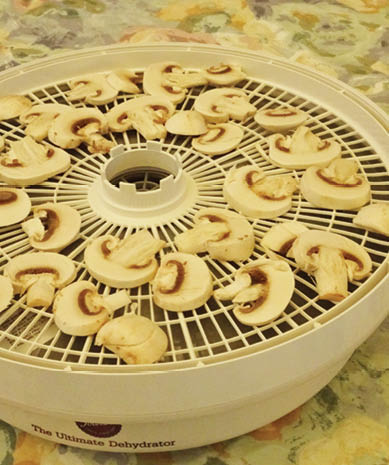


... and bagged ready for the walk

Mushrooms before dehydrating ...
Sun drying is the oldest known type of food preservation and is still used in many parts of the world. It is a slow process and relies on the elements, taking up to four days to dry some fruit. You need to have a certain high temperature and low humidity for this process to be successful.
Sun drying will dry food up to about 15% moisture content. This moisture content is okay for some food items, such as dried fruits and sun dried tomatoes, but not all. At that moisture level, bacteria, yeast and mould can still grow.
Micro-organisms get their water from food in which they grow. Bacteria and yeast require moisture to grow, whereas mould requires moisture to grow, but not as much. Drying food can inhibit micro-organism growth.
When you dry your own food at home it may not reach the low moisture content as the shop-bought food. Commercial driers have different equipment and stringent quality checks. For example, water activity (Aw) is monitored to ensure the moisture content is at a specific level, so no micro-organisms can grow. I doubt that you would have an Aw meter at your house to check the moisture content.
Dehydration refers to an artificial drying under controlled conditions, which removes nearly all the water from food. The final moisture content of the food is about 1-5%.
The basics of dehydrating foods are to heat the food with a dry, circulating air source to absorb and carry the moisture away. The time taken depends on the water content of the food, the size of food pieces, the humidity of the room, the rate of circulating air, the temperature of the dehydrator, and what method of drying you use.
Some foods need to be treated before dehydrating. Blanching vegetables kills off those natural food enzymes present and micro-organisms that can create off colours and flavours. Thoroughly cook meats, or entire meals before placing them in the dehydrator. Do not try dehydrating fatty foods or dairy products - they will go off quickly.
Make sure when preparing your food you cut, slice or dice them as evenly as possible. This will enable the drying time to be consistent with every piece.
“Sun drying will dry food up to about 15% moisture content.
BWA August 2017 | 53
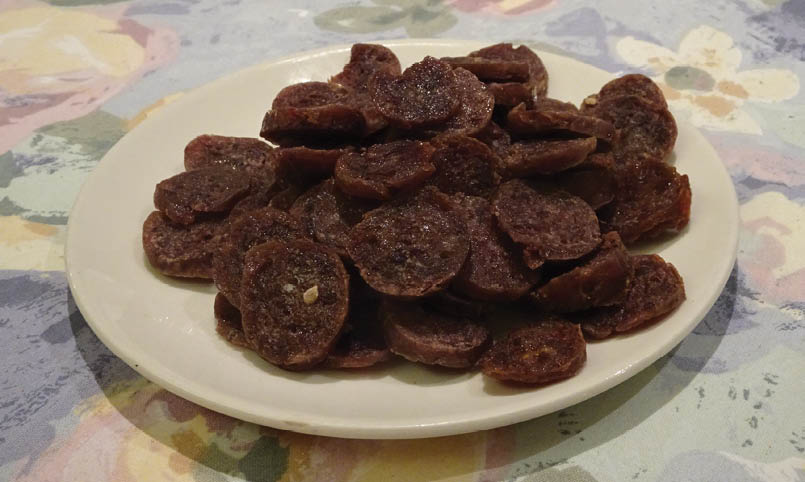

Dehydration can be done by two ways. One is oven drying, well you guessed it, an oven is used for this process. Who would have guessed? This is a simple and long process, about six to eight hours, and the oven needs to stay at around 60-70°C. This process works okay, but it uses more electricity than bench top food dehydrators.
The other method - the bench top dehydrator - is easy to monitor regarding temperature, humidity and drying time as they are specifically designed for the purpose, rather than an oven.
Dehydrated foods are hygroscopic, which means they absorb moisture from the air, and each food has its own equilibrium relative humidity. This is the humidity at a given temperature at which the food will neither lose or pick up moisture from the atmosphere.
Conditioning is “equalising” the moisture, helps prevent mould, and should be done to fruit before you storing. Once dried and cooled, loosely pack the fruit in glass jars or plastic bags and let stand for about a week or two. Shake the food daily to check for condensation or moisture. If moisture is seen, dehydrate it again.
Dried and dehydrated foods should be stored in air-tight containers, preferably in the kitchen pantry. As explained the food absorbs moisture from the air. Check the jars occasionally to see if they are still dry. If the food has gone mouldy, throw it out. You can freeze the dehydrated food for a longer shelf life, but if not wrapped carefully it can suffer freezer burn. It is still okay to eat.
The shelf life of dehydrated foods can range from a few months to a few years; it depends on the storage conditions and water content; the higher the water content, the shorter the shelf life.
The nutrient and sugar content will become concentrated in dried and dehydrated foods, so the flavour may be stronger. Also, vitamin A and C can be lost in the pre-treatment and dehydration processes.
Just for the record, freeze dried foods are significantly different to dried or dehydrated foods. Freeze drying is a process called sublimation and is a very high-tech process. The food is dried to around 1-2% and lasts for many, many years. You can’t do this process at home.
The sausages have been pre-cooked (boiled), prior to dehydrating
54 | BWA August 2017
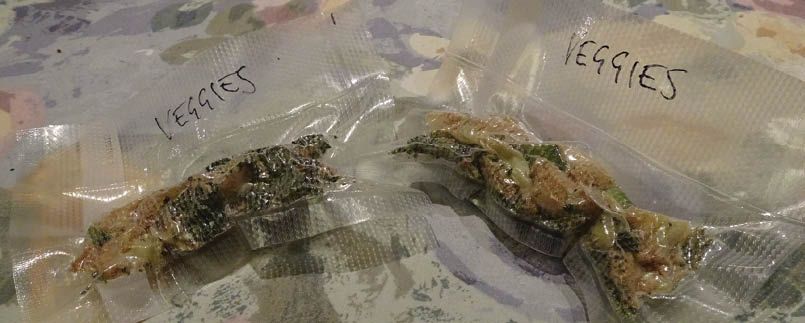
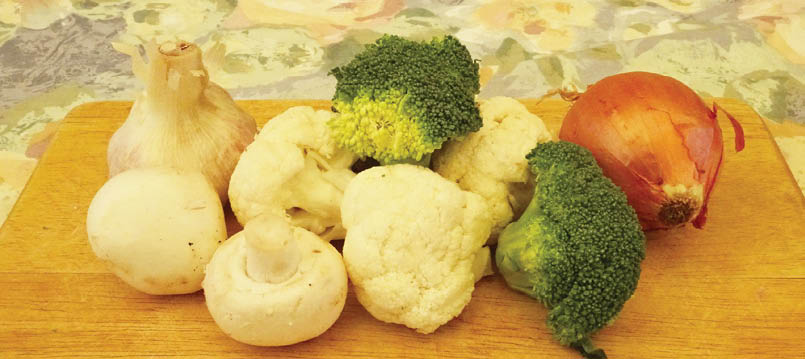


Fresh veggies before drying ...
This table shows the weight difference between food just prior to and after dehydrating.
Food
Weight after cooking or raw grams
Weight after dehydrating grams
Steamed veggies
296
38
Garlic and onions
86
16
Mushrooms
109
10
Chicken
144
59
Sausages
318
135
One very last thing, if you are concerned about fires occurring on your bench top by leaving your dehydrator on for long hours at a time, either raise the dehydrator on blocks of wood or put the dehydrator on a metal surface (like biscuit trays). So now you know nearly everything about dehydrating, oh and did I mention it is way cheaper than buying pre-packaged dehydrated foods ... go on, get shopping for a dehydrator and get in that kitchen and start dehydrating your meals.
Many thanks to my friend Steven Buchert for the dehydrating photos and weights.
... and ready for the trip
“You can freeze the dehydrated food for a longer shelf life, but if not wrapped carefully it can suffer freezer burn.
BWA August 2017 | 55